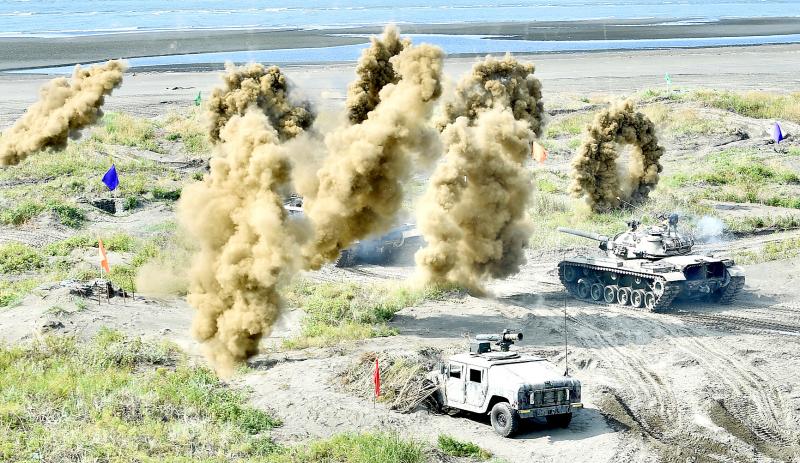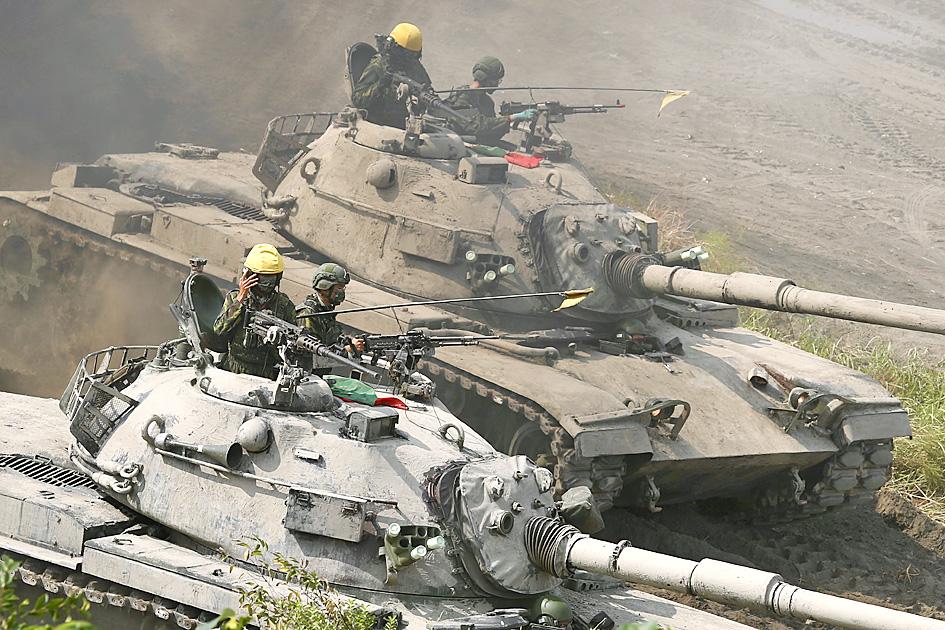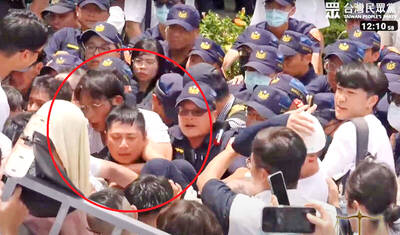The government yesterday proposed extra defense spending of NT$240 billion (US$8.66 billion) over the next five years, including on new missiles, as it warned of an urgent need to upgrade weapons in the face of “severe threats” from China.
President Tsai Ing-wen (蔡英文) has made modernizing the armed forces and increasing defense spending a priority, especially as Beijing ramps up military and diplomatic pressure against the nation.
The money, which comes on top of planned military spending of NT$471.7 billion for next year, would need to be approved by the Legislative Yuan, where Tsai’s ruling Democratic Progressive Party has a large majority, meaning its passage should be smooth.

Photo: Peter Lo, Taipei Times
“The Chinese communists have continued to invest heavily in national defense budgets, its military strength has grown rapidly, and it has frequently dispatched aircraft and ships to invade and harass our seas and airspace,” the Ministry of National Defense said in a statement after a weekly Cabinet meeting.
“In the face of severe threats from the enemy, the nation’s military is engaged in military building and preparation work, and it is urgent to obtain mature and rapid mass production weapons and equipment in a short period of time,” it added.
Deputy Minister of National Defense Wang Shin-lung (王信龍) said the new weapons would be made domestically, as the nation boosts its production prowess, although the US would probably remain an important parts and technology provider.

Photo: Ritchie B. Tongo, EPA-EFE
Taiwan has been keen to demonstrate that it can defend itself, especially amid questions about whether the US would come to its aid if China attacked.
Premier Su Tseng-chang (蘇貞昌) said during the Cabinet meeting that there was great need to augment the military’s combat capabilities, especially for the naval and air force branches.
The special budget has prioritized domestically produced armaments, which could lead to increased corporate investment in the national defense supply chain, creating a win-win scenario for boosting economic growth and autonomous national defense production capabilities, Su said.
The weapons it aims to buy include cruise missiles and warships, the ministry said.
Eight categories of missiles are to be built domestically as part of the budget, Wang said.
They include coastal anti-surface missile systems; the Antelope air defense system; the Tien Kung III (Sky Bow III) land-based surface-to-air missile; an attack drone system; the Wan Chien (Thousand Swords) missile system and the Hsiung Feng IIE (Brave Wind) missile system, he said.
The special budget also calls for the installation of combat systems on Coast Guard Administration ships and continuing the Indigenous Shipbuilding Program, he added.
All items are considered critical if the military is to rapidly build up its combat capabilities, Wang said.
The ministry would provide more details on each item during a budget review, he added.
The announcement came as Taiwan is in the middle of its annual Han Kuang military exercises, which began on Monday and are to end today.
The army yesterday simulated fending off an invasion, firing artillery from a beach on the southern coast.
The exercises, Taiwan’s major war games, have been held annually since 1984, in the form of live-fire drills and computerized war games, to test the military’s combat readiness in the face of a possible Chinese invasion.
Additional reporting by CNA

TPP RALLY: The clashes occurred near the Chiang Kai-shek Memorial Hall on Saturday at a rally to mark the anniversary of a raid on former TPP chairman Ko Wen-je People who clashed with police at a Taiwan People’s Party (TPP) rally in Taipei on Saturday would be referred to prosecutors for investigation, said the Ministry of the Interior, which oversees the National Police Agency. Taipei police had collected evidence of obstruction of public officials and coercion by “disorderly” demonstrators, as well as contraventions of the Assembly and Parade Act (集會遊行法), the ministry said in a statement on Sunday. It added that amid the “severe pushing and jostling” by some demonstrators, eight police officers were injured, including one who was sent to hospital after losing consciousness, allegedly due to heat stroke. The Taipei

NO LIVERPOOL TRIP: Taiwan’s Lin Yu-ting, who won a gold medal in the boxing at the Paris Olympics, was embroiled in controversy about her gender at that event Taiwanese boxer Lin Yu-ting (林郁婷) will not attend this year’s World Boxing Championships in Liverpool, England, due to a lack of response regarding her sex tests from the organizer, World Boxing. The national boxing association on Monday said that it had submitted all required tests to World Boxing, but had not received a response as of Monday, the departure day for the championships. It said the decision for Lin to skip the championships was made to protect its athletes, ensuring they would not travel to the UK without a guarantee of participation. Lin, who won a gold medal in the women’s 57kg boxing

The US has revoked Taiwan Semiconductor Manufacturing Co’s (TSMC, 台積電) authorization to freely ship essential gear to its main Chinese chipmaking base, potentially curtailing its production capabilities at that older-generation facility. American officials recently informed TSMC of their decision to end the Taiwanese chipmaker’s so-called validated end user (VEU) status for its Nanjing site. The action mirrors steps the US took to revoke VEU designations for China facilities owned by Samsung Electronics Co and SK Hynix Inc. The waivers are set to expire in about four months. “TSMC has received notification from the US Government that our VEU authorization for TSMC Nanjing

‘NOT ALONE’: A Taiwan Strait war would disrupt global trade routes, and could spark a worldwide crisis, so a powerful US presence is needed as a deterrence, a US senator said US Senator Deb Fischer on Thursday urged her colleagues in the US Congress to deepen Washington’s cooperation with Taiwan and other Indo-Pacific partners to contain the global security threat from China. Fischer and other lawmakers recently returned from an official trip to the Indo-Pacific region, where they toured US military bases in Hawaii and Guam, and visited leaders, including President William Lai (賴清德). The trip underscored the reality that the world is undergoing turmoil, and maintaining a free and open Indo-Pacific region is crucial to the security interests of the US and its partners, she said. Her visit to Taiwan demonstrated ways the